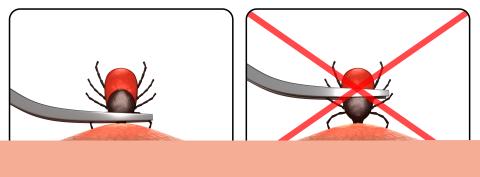According to the Centers for Disease Control and Prevention (CDC), “Tick exposure can occur year-round, but ticks are most active during warmer months (April-September).” Some Whitewater residents are reporting that already this year they’ve seen or pulled off themselves many ticks. It’s important to protect ourselves against Lyme disease and other diseases that may be spread by ticks. Johns Hopkins Medicine reports that, “Depending on the location, anywhere from less than 1% to more than 50% of the ticks are infected with it [Lyme disease.] While most tick bites are harmless, several species can cause life-threatening diseases.”
There are many steps you can take to protect yourself from tick bites.
Use repellent on skin and clothing

Use insect repellents on exposed skin and clothes to prevent tick bites. Repellents should contain one of these:
- 20–30% DEET
- 10–20% Picaridin
- 15–20% IR3535
- 30–40% oil of lemon eucalyptus
Parents should apply repellents to children. Use caution and avoid hands, eyes, and mouth. Don’t use oil of lemon eucalyptus on children under 3 years of age.
Permethrin is a pesticide that kills ticks when they crawl on your clothes. Apply it to clothes, shoes, and gear to prevent tick bites. Don’t apply directly to skin. After applied, permethrin lasts through several washes.
Carefully apply repellents according to the label instructions. Some products should be applied more often than others.
Find the Repellent that is Right for You on the Environmental Protection Agency website.
For more details, visit our webpage on Tick and Insect Repellents. Learn more with the Insect Repellent Essentials: A Brief Guide (PDF) from the Northeast Regional Center for Excellence in Vector-borne Diseases.
Wear the right outdoor clothing.
- Wear long sleeves, long pants, and tall socks. This helps keep ticks on the outside of clothing rather than on your skin.
- Wear light-colored clothing to make ticks easier to spot.
- Tuck shirts into pants, and tuck pants into shoes or socks. This keeps ticks on the outside of clothing.
- Take extra care if you’ll be outdoors for a long time. Tape pant legs where pants and socks meet so ticks can’t crawl under clothes.
Avoid direct contact with ticks
- Walk in the center of trails
- Don’t brush up against plants on the edge of trails.
- Avoid wooded and brushy areas with tall grass and leaf litter.
Check for ticks after being outdoors.
- Perform full-body tick checks after being outdoors in areas where ticks may be present. This could include your own yard. Check yourself and family members every day after being outdoors where ticks may be present.
- Check all parts of the body carefully. Pay special attention to the armpits, behind the knees, scalp, in and around the ears, inside the belly button, and groin.
- Parents should check their children for ticks.
- Before going inside, make sure your clothing, gear, and pets don’t have ticks. For pets, use a treatment recommended by a veterinarian to prevent ticks.
- Take a bath or shower within two hours after coming inside. This helps you find and wash off any ticks on your body.
- Tumble dry clothes in a dryer on high heat for 10 minutes. The heat kills any ticks still on your clothing. If clothes are damp, tumble dry on high heat for 60 minutes.
Tick removal—dos and don’ts
Don’t panic if you find a tick embedded on your body. Simply remove it as soon as possible following these recommendations:
Do:
- Grasp tick with a narrow-bladed tweezers as close as possible to the skin.
- If tweezers are not available, use fingers shielded with tissue paper or rubber gloves.
- Pull upward and out with a firm and steady tension.

Don’t:
- Don’t use petroleum jelly, a hot match, nail polish, or other products.
- Don’t handle tick with bare hands.
- Don’t squeeze, crush, or puncture the body of the tick, which may contain infectious fluids.
- Don’t twist the tick, since this can cause the mouthparts to break off and stay in the skin.
After removing the tick, use rubbing alcohol to clean the bite site and wash your hands with soap and water. It is important that a tick be properly removed as soon as it’s found.
Visit your doctor if you have a rash or fever within 30 days of removing a tick or after possible tick exposure. Tell the doctor when and where you may have come into contact with the tick.
If I’ve been bitten by a tick, should I get it tested?
If you have been bitten by a tick, getting it tested for any diseases isn’t recommended. The only way to know if a tick bite made you sick is through an evaluation performed by a health care provider. Learn more about tick testing at Ticks in Wisconsin: What You Need to Know.
Editor’s note: The image on the homepage is from here.






















